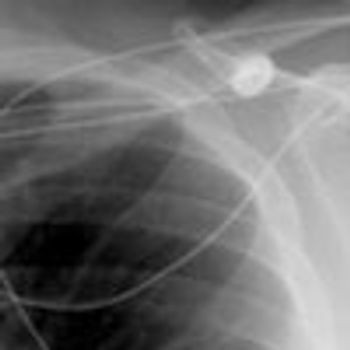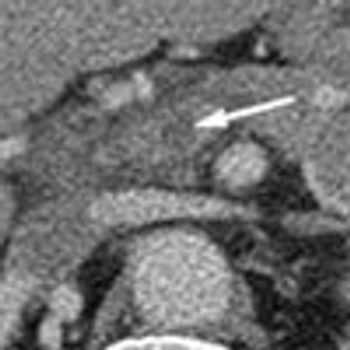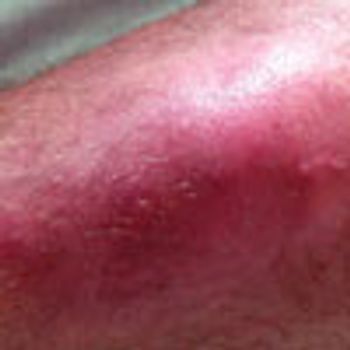
A 71-year-old man complains of left elbow pain that increases with movement and has worsened over the past 12 hours. He has also had a cough with sputum production for the past several days.

A 71-year-old man complains of left elbow pain that increases with movement and has worsened over the past 12 hours. He has also had a cough with sputum production for the past several days.

I work for the Child Protection Team at a local university. Recently, I saw a 9-year-old girl who had been taken to the local emergency department (ED) with sudden left-sided abdominal pain.

Parents of young children know that colds are extremely common, especially from fall until spring. Colds account for a large number of pediatric office visits and telephone calls-particularly during "cold season."

A 53-year-old man, who had initially presented with an upper respiratory tract infection, was found to have a stage IV follicular low-grade lymphoma with malignant cells that were positive for CD19, CD20, CD10, surface kappa, and CD45 and negative for CD5. A grade 1 tumor (follicular center cell lymphoma/follicular small cleaved) was suspected. Enlarged lymph nodes (2.5 to 4.0 cm) were found in the mediastinum, azygoesophageal recess, and periaortic region as well as in the porta hepatis, peripancreatic, mesenteric, and celiac regions.

For 3 years, my 30-year-old patient has had outbreaks of small, vesicular, frequently pruritic lesions on the neck and upper trunk.

A 22-year-old woman has had chronic nausea, emesis with green vomitus, and diarrhea for the past 10 months. The diarrhea is frequent (about 3 to 8 times daily) and does not resolve with starvation.

For 2 weeks, a 49-year-old woman has had mild, intermittent epistaxis with left-sided facial pain, swelling, and otalgia; the severity of the bleeding has increased during the past 24 hours. She also has congestion of the left naris of 1 month's duration.

Several recent studies from Europe and the United States confirm that tailoring the dosage and duration of pegylated interferon alfa 2b and ribavirin therapy can optimize treatment of hepatitis C virus (HCV) infection.

New guidelines for community-acquired pneumonia (CAP) issued jointly by the Infectious Diseases Society of America and the American Thoracic Society emphasize the need for communities to adapt the recommendations to local conditions.

In the vast majority of nonsmokers who are not receiving angiotensin converting-enzyme inhibitors and who have no evidence of active disease on chest radiographs, chronic cough is caused by postnasal drip syndrome (recently renamed upper airway cough syndrome [UACS]), asthma, non-asthmatic eosinophilic bronchitis, or gastroesophageal reflux disease (GERD), alone or in combination.

A 57-year-old woman presents for follow-up several months after a series of thrombotic episodes. Four days after she underwent ankle fusion to relieve pain and edema associated with a leg fracture that had occurred 40 years earlier, she sustained a massive myocardial infarction (MI).

A 63-year-old African American man presented with severe epigastric pain of 1 day's duration. The pain was sharp and continuous and radiated toward the left flank. There were no aggravating or relieving factors or previous similar episodes.


Transverse depressions like the one shown here appeared on all the other nails of this 68-year-old man several weeks after he had suffered a myocardial infarction.

Dr Thomas Fekete's recent article on emerging infections (CONSULTANT, October 2007) was timely, given recent evidence that the incidence of methicillin-resistant Staphylococcus aureus (MRSA) infection, both hospital-acquired and community-acquired, has assumed pandemic proportions.

The first step in the workup of a patient with a persistent asymptomatic alkaline phosphatase (ALP) elevation is to measure gamma-glutamyltranspeptidase to determine whether the elevation is liver-related or bone-related.

Nephropathy develops in about 30% of patients with diabetes. Screen for albuminuria at the time type 2 diabetes is diagnosed and within 5 years of diagnosis of type 1 diabetes.


Acute abdominal pain, fever, and chills prompted a 51-year-old man to visit his local hospital twice in one week. On both visits, a clinical and laboratory workup was negative. He then presented to a tertiary care center with worsening symptoms. His history included hypertension and tobacco and alcohol use.

A 44-year-old man presented to the emergency department (ED) with pain and swelling of the left ankle and a petechial rash in the pretibial area that developed the night before. He also reported "fluttering" in his chest.

A 75-year-old man is concerned about the discoloration of his fingernails: each nail has dark bands with a clearing in the middle.

A 37-year-old man presents with moderately pruritic urticarial papules on areas of his skin that are not covered by his shorts and T-shirt. He recently returned from a trip to Upstate New York, where he had stayed in several rustic cabins that were used by different people daily.

Determining the cause of generalized weakness can be a daunting task, since the differential diagnosis is vast. An overall approach to the patient who complains of generalized weakness is presented in our article

The differential diagnosis of generalized weakness is enormous; it includes disorders at all levels of the neur-axis. A variety of electrophysiological, pathological, radiographic, and other laboratory studies may be indicated depending on the specific diagnostic possibilities; costs can be controlled if such investigations are selected judiciously.

Identifying the cause of a persistent, asymptomatic aminotransferase elevation can be challenging. The possible diagnoses are many and varied. To narrow the differential, begin with a detailed history.